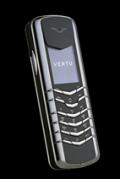Much like the first automobiles, the first cell phones were all black. Nokia was the first to introduce colorful removable faceplates to the world of mobile devices, and their newest phones continue to push the boundaries of cell design.
Their 7360, 7370, and 7380 models are fashion or luxury phones; the designs are informed by romantic Asian floral patterns and steely, high-rise style alike. The metal, silk, leather, and ceramic surfaces of the three devices appear in a range of metallic ambers and bronzes and are etched and enameled with floral motifs.
Nokia plugs these heartbreakingly trendy phones' designs as "infusing cultural and ethnic influences with luxurious touches of the unexpected. Hints of vintage and craftsmanship are fused with natural materials, colors, and patterns—all carefully crafted and layered with a passion for detail."
Nokia senior designer Tanja Fisher said, "Today, you can see a broad spectrum of ethnic and craft-style applications in the apparel, fashion, and even furniture industry. It is wonderful that today, traditions are rediscovered by designers reviving long-lost techniques and making them fashionable again—for example, the crochet by Marc Jacobs."
Like all status symbols, the phones carry a hefty price tag along the lines of what one would pay for a designer handbag, scarf, or pair of shoes. The line's predecessor, the chic black-and-red 7280, currently retails at around $300; the soon-to-be-released 7380 can be found online for between $600 and $800.
Previously, marketing to the upper-middle-class female demographic had been limited, and a few attempts to create a fashion-friendly mobile device remain as artifacts in the Cell Phone Hall of Shame.
Motorola's only attempts to woo female consumers were a hot-pink body for an otherwise unmodified RAZR V3—its trendiest and most popular cell phone—and a standard flip phone partially covered in almost 12 carats of Russian-cut, pavé-set diamonds. Early in December 2005, it announced the release of 1,000 Dolce & Gabbana gold-finished RAZRs. As the designer-phone gimmick has failed in recent past, one hopes that the RAZR's popularity will be enough to save the D&G version from scathing reviews.
Samsung's disastrous collaboration with style icon and designer Diane Von Furstenburg gave birth to the DVF Mobile, a tangerine-hued clamshell with a reproduction of DVF's Andy Warhol portrait on the faceplate. Reviewed as "affected" and even "ugly," the phone did not make further appearances after its initial limited release.
Another Samsung clamshell model, the T500, featured a faceplate with an analog timepiece surrounded by gemstones; it seemed that the designers were fresh out of inspiration and opted to rip off a ladies' watch face.
Seimens' almond-shaped Xelibri 4, with its V-shaped keypad and seafoam body, was designed using the theme "Space on Earth." Although vigorously marketed as stylish accessories, the devices in the Xelibri line were withdrawn from the market after about 18 months of lackluster sales.
With a crude aesthetic based on the assumption that chicks dig pink, sparkly stuff and the supposition that women don't get or want technology, it's no shock that none of the abovementioned models has enjoyed more than a year or so on the market.
One disturbing factor about all these earlier exploratory missions into the fusion of phone and fashion was the complete lack of all the fun, techie features that these companies were loading onto the standard phones marketed primarily toward men. The majority of these models were light on features and functions. None of them had Bluetooth connectivity, cameras, or music-playing capabilities; and sluggish software was an issue in some cases.
Not so with the L'Amour line. Far superior to the awkward-looking, feature-light clamshells of the past, the new phones promise elegance and status to users, as well as a complete portfolio of features. The lipstick-shaped 7380 offers users a glass mirror display with light-enhanced effects, an mp3 player, and FM radio. The 7370 swivel phone boasts 3D stereo speakers and a multimode Web browser. Each device also has a range of voice command and hands-free options and a camera; the 7360 also records video.
Perhaps most important, the new phones are being appropriately marketed to the haute-couture crowd. Unlike the clumsy ad copy for earlier phones (what sane woman wants to have a look that can be described as "Space on Earth"?), these chic models are complemented by a brilliant campaign as slick as the mobiles themselves.
According to senior designer Liisa Puolakka, early research at Paris textile shows and in the rising marketplace of experimental jewelry "indicated the emergence of a group of discerning fashion connoisseurs who admired art and intellect and lived in an economy that rewarded their particular skills.
"This trend indicated a shift in fashion towards a new concept of luxury, shaping a connoisseur-like approach to consumption with high expectations for multi-sensorial experiences."
Nokia intends for the L'Amour Collection to capture the eyes, ears, and dollars of the most style-conscious, fashion-forward women; and early reviews bode well for the line's success.
Ultimately, said Fisher, "Fashion is no longer just about what we wear or our hairstyles. Fashion is now the complete fusion of a life attitude.
"The products we buy are now part of our constantly changing lifestyles. The L'Amour Collection was created to blur these boundaries between individual expression and technology."





